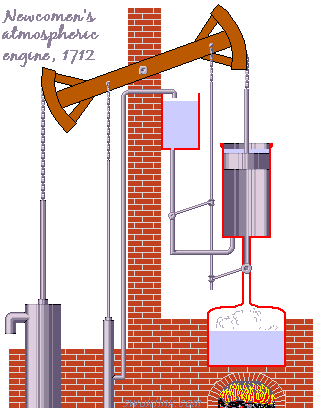The various elements of the steam engine had all been devised and applied by the beginning of the eighteenth century. Pressure was understood as was the vacuum created by the displacement of the air by steam and the subsequent condensation of the water vapor. The creation of a partial vacuum by condensation had been successfully used by Morland, Denis Papin, and Thomas Savery. Steam boilers capable of providing useful pressures had been made and their safety was facilitated by Papin's safety valve. Steam powered pistons had also been created and it only remained for an engineer to devise an efficient engine which could be harnessed to sustained useful work.
The first practicable, albeit crude, steam engine was demonstrated before the Royal Institution in 1698 and later in the same year obtained a royal patent for fourteen years for his "fire engine". It is possible that Savery based his machine on the designs for a high pressure steam engine of Denis Papin published in his De Novis Quibusdam Machinis published in 1690.
Thomas Hooke passed Papin's pamphlet to Thomas Newcomen (1664-1729), an ironmonger and blacksmith of Dartmouth in Devon with scant knowledge of mathematics, who devised the "Atmospheric Steam Engine". Newcomen joined forces with Savery who held the patent for condensing the steam in the cylinder of the engine in 1705.
The valves of these early steam engines were operated by hand and one such operator, a boy named Humphrey Potter, is creditted with having devised a system for operating the valves by means of strings attached to the engine thereby making himself redundant.

It is the high pressure steam engine which is traditionally explained at school where the steam pushes the piston to do work. These engines only made their appearance later. The piston in the "atmospheric" engine was raised by the steam from the boiler, helped by the weight of the pump rod attached to the opposite end of the beam. At the top of the stroke of the piston, a cold water spray was injected into cylinder which caused the steam to condense causing a partial vacuum. The upper surface of the piston was exposed to the air and atmospheric pressure would force down the piston to produce the "power stroke" which lifted the water.
Steam engines were further developed by John Smeaton (1724-1792) and James Watt (1736-1819). Watt was given a model of Newcomen's engine to repair in 1765 and realised that it could be improved by a separate condenser. He worked on the problem until he built a successful engine in 1776. He also devised the sun-and-planet gear to convert the reciprocating motion of the engine to the circular motion of the flywheel.
The "high pressure" steam engine, utilising the expansive force of the steam, was
developed around 1800 independently by the Cornish engineer Richard Trevithick in
Britain and Oliver Evans in America.
By the closing decades of the eighteenth century, steam engines were performing tasks as varied as the drainage of tin and copper mines in Cornwall, coal mines elsewhere, replacing the thausands of windmills required to drain the Low Countries, pumping water to supply London and other large connurbations and pumping the air required by blast furnaces to produce iron in large quantities. Steam engines also raised the water required by canals but, developed as steam locomotives in the 1820s and 30s, allowed the new railways which proliferated in the 1840s to supplant the canals.
The steam turbines which developed after the reciprocating steam engines are still used today for applications such as electricity generation, even in state-of-the-art nuclear power stations.
|
| | | Links to Other Pages on This Site
|
| |
| | |
|
| | | Links to Other Sites
|
| |
| | |
|
| | | Links to Other Pages on this Site
|
| |
| | |
Recommend a Book for this Page
Hits on this page since December 6th| Jan | | |  | | 1 | | Feb | | |  | | 2 | | Mar | | |  | | 2 | | Apr | | | | | | | May | | | | | | | Jun | | | | | | | Jul | | | | | | | Aug | | | | | | | Sep | | | | | | | Oct | | | | | | | Nov | | | | | | | Dec | | |  | | |
current year:  | | previous year:  |
DISCLAIMER: Whilst we endeavour to ensure the content of this site is correct, we cannot undertake that information you find here, is, or will remain accurate and complete. We do not warrant that any information contained on this site is fit for any purpose. If you wish to place reliance on any such information you must check its accuracy by some other means before doing so. If you are in any way connected with any location mentioned on this site or have an interest in any of its contents and have an hour or two a month to spare, we would welcome you as a local moderator - please email the webmaster by CLICKING HERE. Privacy Policy
|
| 






